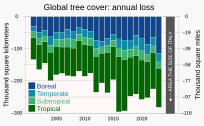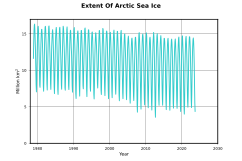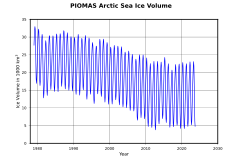Habitat destruction

Habitat destruction (also termed habitat loss and habitat reduction) occurs when a natural habitat is no longer able to support its native species. The organisms once living there have either moved to elsewhere or are dead, leading to a decrease in biodiversity and species numbers.[1][2] Habitat destruction is in fact the leading cause of biodiversity loss and species extinction worldwide.[3]
Humans contribute to habitat destruction through the use of natural resources, agriculture, industrial production and urbanization (urban sprawl). Other activities include mining, logging and trawling. Environmental factors can contribute to habitat destruction more indirectly. Geological processes, climate change,[2] introduction of invasive species, ecosystem nutrient depletion, water and noise pollution are some examples. Loss of habitat can be preceded by an initial habitat fragmentation. Fragmentation and loss of habitat have become one of the most important topics of research in ecology as they are major threats to the survival of endangered species.[4]
Observations
By region
Regions of un
Areas of high agricultural output tend to have the highest extent of habitat destruction. In the U.S., less than 25% of native vegetation remains in many parts of the East and Midwest.[8] Only 15% of land area remains unmodified by human activities in all of Europe.[7]
Currently, changes occurring in different environments around the world are changing the specific geographical habitats that are suitable for plants to grow. Therefore, the ability for plants to migrate to suitable environment areas will have a strong impact on the distribution of plant diversity. However, at the moment, the rates of plant migration that are influenced by habitat loss and fragmentation are not as well understood as they could be.[9]
By type of ecosystem

Tropical rainforests have received most of the attention concerning the destruction of habitat. From the approximately 16 million square kilometers of tropical rainforest habitat that originally existed worldwide, less than 9 million square kilometers remain today.[7] The current rate of deforestation is 160,000 square kilometers per year, which equates to a loss of approximately 1% of original forest habitat each year.[10]
Other forest
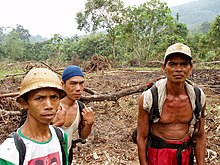
Plains and
Natural causes
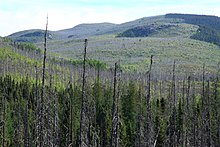
Habitat destruction through natural processes such as volcanism, fire, and climate change is well documented in the fossil record.[2] One study shows that habitat fragmentation of tropical rainforests in Euramerica 300 million years ago led to a great loss of amphibian diversity, but simultaneously the drier climate spurred on a burst of diversity among reptiles.[2]
Causes due to human activities
Habitat destruction caused by humans includes
Overarching drivers
The forces that cause humans to destroy habitat are known as drivers of habitat destruction.
Demographic drivers include the
According to the Geist and Lambin (2002) study, the underlying driving forces were prioritized as follows (with the percent of the 152 cases the factor played a significant role in): economic factors (81%), institutional or policy factors (78%), technological factors (70%), cultural or socio-political factors (66%), and
Forest conversion to agriculture
Geist and Lambin (2002) assessed 152 case studies of net losses of tropical forest cover to determine any patterns in the proximate and underlying causes of tropical deforestation. Their results, yielded as percentages of the case studies in which each parameter was a significant factor, provide a quantitative prioritization of which proximate and underlying causes were the most significant. The proximate causes were clustered into broad categories of
Habitat size and numbers of species are systematically related. Physically larger species and those living at lower latitudes or in forests or oceans are more sensitive to reduction in habitat area.[23] Conversion to "trivial" standardized ecosystems (e.g., monoculture following deforestation) effectively destroys habitat for the more diverse species. Even the simplest forms of agriculture affect diversity – through clearing or draining the land, discouraging weeds and pests, and encouraging just a limited set of domesticated plant and animal species.[23]
There are also feedbacks and interactions among the proximate and underlying causes of deforestation that can amplify the process. Road construction has the largest feedback effect, because it interacts with—and leads to—the establishment of new settlements and more people, which causes a growth in wood (logging) and food markets.[19] Growth in these markets, in turn, progresses the commercialization of agriculture and logging industries. When these industries become commercialized, they must become more efficient by utilizing larger or more modern machinery that often has a worse effect on the habitat than traditional farming and logging methods. Either way, more land is cleared more rapidly for commercial markets. This common feedback example manifests just how closely related the proximate and underlying causes are to each other.[24]
Climate change
Climate change contributes to destruction of some habitats, endangering various species. For example:
- Climate change causes rising sea levels which will threaten natural habitats and species globally.[25][26]
- Melting sea ice destroys habitat for some species.[27]: 2321 For example, the decline of sea ice in the Arctic has been accelerating during the early twenty‐first century, with a decline rate of 4.7% per decade (it has declined over 50% since the first satellite records).[28][29][30] One well known example of a species affected is the polar bear, whose habitat in the Artic is threatened.[31] Algae can also be affected when it grows on the underside of sea ice.[32]
- coastal protection and food. But 70–90% of today's warm-water coral reefs will disappear even if warming is kept to 1.5 °C (2.7 °F).[33]: 179 For example, Caribbean coral reefs – which are biodiversity hotspots – will be lost within the century if global warming continues at the current rate.[34]
Habitat fragmentation
Impacts
On animals and plants
When a habitat is destroyed, the
Habitat loss is perhaps the greatest threat to organisms and biodiversity.
As habitat destruction of an area occurs, the species diversity offsets from a combination of habitat generalists and specialists to a population primarily consisting of generalist species.[3] Invasive species are frequently generalists that are able to survive in much more diverse habitats.[44] Habitat destruction leading to climate change offsets the balance of species keeping up with the extinction threshold leading to a higher likelihood of extinction.[45]
Habitat loss is one of the main environmental causes of the decline of biodiversity on local, regional, and global scales. Many believe that habitat fragmentation is also a threat to biodiversity however some believe that it is secondary to habitat loss.[46] The reduction of the amount of habitat available results in specific landscapes that are made of isolated patches of suitable habitat throughout a hostile environment/matrix. This process is generally due to pure habitat loss as well as fragmentation effects. Pure habitat loss refers to changes occurring in the composition of the landscape that causes a decrease in individuals. Fragmentation effects refer to an addition of effects occurring due to the habitat changes.[4] Habitat loss can result in negative effects on the dynamic of species richness. The order Hymenoptera is a diverse group of plant pollinators who are highly susceptible to the negative effects of habitat loss, this could result in a domino effect between the plant-pollinator interactions leading to major conservation implications within this group.[47] It is observed from the worlds longest running fragmentation experiment over 35 years that habitat fragmentation has caused a decrease in biodiversity from 13% to 75%. [48]
On human population
Habitat destruction can vastly increase an area's vulnerability to
Agricultural land can suffer from the destruction of the surrounding landscape. Over the past 50 years, the destruction of habitat surrounding agricultural land has degraded approximately 40% of agricultural land worldwide via erosion, salinization, compaction, nutrient depletion, pollution, and urbanization.[16] Humans also lose direct uses of natural habitat when habitat is destroyed. Aesthetic uses such as birdwatching, recreational uses like hunting and fishing, and ecotourism usually[quantify] rely upon relatively undisturbed habitat. Many[quantify] people value the complexity of the natural world and express concern at the loss of natural habitats and of animal or plant species worldwide.[53]
Probably the most profound impact that habitat destruction has on people is the loss of many valuable
The loss of trees from tropical rainforests alone represents a substantial diminishing of Earth's ability to produce oxygen and to use up carbon dioxide. These services are becoming even more important as increasing
The negative effects of habitat destruction usually impact rural populations more directly than urban populations.[16] Across the globe, poor people suffer the most when natural habitat is destroyed, because less natural habitat means fewer natural resources per capita, yet wealthier people and countries can simply pay more to continue to receive more than their per capita share of natural resources.
Another way to view the negative effects of habitat destruction is to look at the opportunity cost of destroying a given habitat. In other words, what do people lose out on with the removal of a given habitat? A country may increase its food supply by converting forest land to row-crop agriculture, but the value of the same land may be much larger when it can supply natural resources or services such as clean water, timber, ecotourism, or flood regulation and drought control.[16][need quotation to verify]
Outlook
The rapid expansion of the global human population is increasing the world's food requirement substantially. Simple logic dictates that more people will require more food. In fact, as the world's population increases dramatically, agricultural output will need to increase by at least 50%, over the next 30 years.[56] In the past, continually moving to new land and soils provided a boost in food production to meet the global food demand. That easy fix will no longer be available, however, as more than 98% of all land suitable for agriculture is already in use or degraded beyond repair.[57]
The impending global
Solutions
Attempts to address habitat destruction are in international policy commitments embodied by Sustainable Development Goal 15 "Life on Land" and Sustainable Development Goal 14 "Life Below Water". However, the United Nations Environment Programme report on "Making Peace with Nature" released in 2021 found that most of these efforts had failed to meet their internationally agreed upon goals.[58]
Tropical deforestation: In most cases of
Shoreline erosion: Coastal erosion is a natural process as storms, waves, tides and other water level changes occur. Shoreline stabilization can be done by barriers between land and water such as seawalls and bulkheads. Living shorelines are gaining attention as a new stabilization method. These can reduce damage and erosion while simultaneously providing ecosystem services such as food production, nutrient and sediment removal, and water quality improvement to society[59]


Preventing an area from losing its specialist species to generalist invasive species depends on the extent of the habitat destruction that has already taken place. In areas where the habitat is relatively undisturbed, halting further habitat destruction may be enough.
Education of the general public is possibly the best way to prevent further human habitat destruction.[61] Changing the dull creep of environmental impacts from being viewed as acceptable to being seen a reason for change to more sustainable practices.[61] Education about the necessity of family planning to slow population growth is important as greater population leads to greater human caused habitat destruction.[62] Habitat restoration can also take place through the following processes; extending habitats or repairing habitats.[63] Extending habitats aims to counteract habitat loss and fragmentation whereas repairing habitats counteracts degradation.[63]
The preservation and creation of habitat corridors can link isolated populations and increase pollination.[64] Corridors are also known to reduce the negative impacts of habitat destruction.[64]
The biggest potential to solving the issue of habitat destruction comes from solving the political, economical and social problems that go along with it such as, individual and commercial material consumption,[61] sustainable extraction of resources,[65] conservation areas,[61] restoration of degraded land[66] and addressing climate change.[45]
Governmental leaders need to take action by addressing the underlying driving forces, rather than merely regulating the proximate causes. In a broader sense, governmental bodies at a local, national, and international scale need to emphasize:
- Considering the irreplaceable ecosystem servicesprovided by natural habitats.
- Protecting remaining intact sections of natural habitat.
- Finding ecological ways to increase agricultural output without increasing the total land in production.
- Reducing contraception globally, furthering gender equalityalso has a great benefit. When women have the same education (decision-making power), this generally leads to smaller families.
It is argued that the effects of habitat loss and fragmentation can be counteracted by including spatial processes in potential restoration management plans. However, even though spatial dynamics are incredibly important in the conservation and recovery of species, a limited amount of management plans are taking the spatial effects of habitat restoration and conservation into consideration.[67]
See also
Notes
- PMID 28811883.
- ^ doi:10.1130/G31182.1. Archivedfrom the original on 11 October 2011. Retrieved 29 November 2010 – via GeoScienceWorld.
- ^ from the original on 23 July 2021. Retrieved 18 March 2021.
- ^ S2CID 33258495.
- ^ "Tierras Bajas Deforestation, Bolivia". Newsroom. Photo taken from the International Space Station on April 16, 2001. NASA Earth Observatory. 16 April 2001. Archived from the original on 20 September 2008. Retrieved 11 August 2008.
- ^ a b c Cincotta & Engelman, 2000.
- ^ a b c d e f g h i j Primack, 2006.
- ^ a b Stein et al., 2000.
- ISSN 0030-1299.
- ^ a b Laurance, 1999.
- ^ Kauffman & Pyke, 2001.
- ^ White et al., 2000.
- ^ Ravenga et al., 2000.
- ^ "United Kingdom: Environmental Issues, Policies and Clean Technology". AZoCleantech.com. 8 June 2015. Archived from the original on 30 March 2019. Retrieved 12 December 2017.
- ^ Burke et al., 2000.
- ^ a b c d e f g h i Millennium Ecological Assessment, 2005.
- ^ "File:Burnt forest GJ.jpg", Wikipedia, archived from the original on 23 July 2021, retrieved 18 March 2021
- ^ McKee et al., 2003.
- ^ a b c d e f Geist & Lambin, 2002.
- ^ Butler, Rhett A. (31 March 2021). "Global forest loss increases in 2020". Mongabay. Archived from the original on 1 April 2021. ● Mongabay graphing WRI data from "Forest Loss / How much tree cover is lost globally each year?". research.WRI.org. World Resources Institute — Global Forest Review. 2023. Archived from the original on 2 August 2023.
- ^ Steffen, Will; Sanderson, Angelina; Tyson, Peter; Jäger, Jill; et al. (2004). "Global Change and the Climate System / A Planet Under Pressure" (PDF). International Geosphere-Biosphere Programme (IGBP). pp. 131, 133. Archived (PDF) from the original on 19 March 2017.
Fig. 3.67(j): loss of tropical rainforest and woodland, as estimated for tropical Africa, Latin America and South and Southeast Asia.
- ^ "Deforestation and Forest Loss / Humanity destroyed one third of the world's forests by expanding agricultural land". Our World in Data (OWID). Archived from the original on 7 November 2022.
Data: Historical data on forests from Williams (2003) - Deforesting the Earth. Historical data on agriculture from The History Database of Global Environment (HYDE). Modern data from the FAO
- ^ PMID 16958886.
- PMID 26269871.
- ISSN 1863-5407.
- S2CID 86365454.
- S2CID 189968828.
- S2CID 210273007.
- S2CID 218762126.
- S2CID 85677324.
- PMID 19995981.
- ISBN 978-1-009-15794-0.
- ^ Aldred, Jessica (2 July 2014). "Caribbean coral reefs 'will be lost within 20 years' without protection". The Guardian. Retrieved 9 November 2015.
- ISSN 2150-8925.
- ^ doi:10.1130/G31182.1.
- S2CID 91260144.
- .
- ^ Scholes & Biggs, 2004.
- ^ Barbault & Sastrapradja, 1995.
- .
- S2CID 86565631.
- ^ "The Panda's Forest: Biodiversity Loss". 24 August 2011. Archived from the original on 23 September 2011. Retrieved 6 September 2011.
- S2CID 14148713.
- ^ PMID 12641900.
- PMID 16958870.
- PMID 24597216.
- PMID 26601154.
- ^ Tibbetts, 2006.
- ^ a b Mumba, Musonda; Munang, Richard; Rivington, Mike (27 June 2013). "Ecosystem Management: The Need to Adopt a Different Approach Under a Changing Climate". Resources Report. United Nations Environment Programme/Macaulay Land Use Research Institute. Archived from the original on 15 April 2021. Retrieved 15 April 2021.
- Pontine marshesof Italy.
- ^
ISBN 9781845939649. Retrieved 30 September 2021.
The eradication of smallpox virus [...] is also a perfect example of habitat destruction: smallpox vaccination gives life-long immunity, and humans are the only host. Mass vaccination therefore resulted in total elimination of the habitat of the virus.
- ^ "Valuing nature". World Wildlife Foundation. WWF. Archived from the original on 25 April 2021. Retrieved 15 April 2021.
- ^
Benoît Geslin; Benoit Gauzens; Elisa Thébault; Isabelle Dajoz (2013). "Plant Pollinator Networks along a Gradient of Urbanisation". PLOS ONE. 8 (5): e63421. PMID 23717421.
- PMID 16903044.
- ^ a b Tilman et al., 2001.
- ^ Sanderson et al., 2002.
- ^ United Nations Environment Programme (2021). Making Peace with Nature: A scientific blueprint to tackle the climate, biodiversity and pollution emergencies. Nairobi. Archived 2021-03-23 at the Wayback Machine
- ^ "Living Shorelines". NOAA Habitat Blueprint. Archived from the original on 18 March 2021. Retrieved 23 March 2021.
- from the original on 23 July 2021. Retrieved 18 March 2021.
- ^ ISBN 0-412-74050-8
- PMID 18695214.
- ^ a b Banks-Leite, Cristina; Mark Ewers, Robert; Folkard-Tapp, Hollie; Fraser, Adam (18 December 2020). "Countering the effects of habitat loss, fragmentation, and degradation through habitat restoration". One Earth. 3 (6): 672–676 – via Cell Press.
- ^ from the original on 23 July 2021. Retrieved 18 March 2021.
- ISBN 978-1-907643-07-1, retrieved 18 March 2021
- ISSN 0021-8901.
- S2CID 86235090.
References
- Barbault, R. and S. D. Sastrapradja. 1995. Generation, maintenance and loss of biodiversity. Global Biodiversity Assessment, Cambridge Univ. Press, Cambridge pp. 193–274. ISBN 9780521564816
- Burke, L.; Y. Kura; K. Kassem; C. Ravenga; M. Spalding; D. McAllister (2000). Pilot Assessment of Global Ecosystems: Coastal Ecosystems. ISBN 9781569734582. Archivedfrom the original on 4 May 2018. Retrieved 19 February 2020.
- Cincotta, R.P., and R. Engelman. 2000. Nature's place: human population density and the future of biological diversity. Population Action International. Washington, D.C.
- Geist H. J.; Lambin E. E. (2002). "Proximate causes and underlying driving forces of tropical deforestation". BioScience. 52 (2): 143–150. .
- Kauffman, J. B. and D. A. Pyke. 2001. Range ecology, global livestock influences. In S. A. Levin (ed.), Encyclopedia of Biodiversity 5: 33–52. Academic Press, San Diego, CA.
- Laurance W. F. (1999). "Reflections on the tropical deforestation crisis". Biological Conservation. 91 (2–3): 109–117. .
- McKee J. K.; Sciulli P.W.; Fooce C. D.; Waite T. A. (2003). "Forecasting global biodiversity threats associated with human population growth". Biological Conservation. 115: 161–164. .
- Millennium Ecosystem Assessment (Program). 2005. Ecosystems and Human Well-Being Archived 2016-06-10 at the Wayback Machine. Millennium Ecosystem Assessment. Island Press, Covelo, CA.
- Primack, R. B. 2006. Essentials of Conservation Biology. 4th Ed. Habitat destruction, pages 177–188. Sinauer Associates, Sunderland, MA.
- Pimm Stuart L.; Raven Peter (2000). "Biodiversity: Extinction by numbers". Nature. 403 (6772): 843–845. S2CID 4310784.
- Ravenga, C., J. Brunner, N. Henninger, K. Kassem, and R. Payne. 2000. Pilot Analysis of Global Ecosystems: Wetland Ecosystems. World Resources Institute, Washington, D.C.
- Sahney S.; Benton M.J.; Falcon-Lang H.J. (2010). "Rainforest collapse triggered Pennsylvanian tetrapod diversification in Euramerica". Geology. 38 (12): 1079–1082. doi:10.1130/G31182.1.
- Sanderson E. W.; Jaiteh M.; Levy M. A.; Redford K. H.; Wannebo A. V.; Woolmer G. (2002). "The human footprint and the last of the wild". BioScience. 52 (10): 891–904. .
- Scholes, R. J. and R. Biggs (eds.). 2004. Ecosystem services in Southern Africa: a regional assessment. The regional scale component of the Southern African Millennium Ecosystem Assessment. Archived 2020-10-02 at the Wayback Machine CSIR, Pretoria, South Africa.
- Stein, B. A., L. S. Kutner, and J. S. Adams (eds.). 2000. Precious Heritage: The Status of Biodiversity in the United States. Oxford University Press, New York.
- Temple S. A. (1986). "The Problem of Avian Extinctions". Current Ornithology. Vol. 3. pp. 453–485. ISBN 978-1-4615-6786-8.
- Tibbetts John (2006). "Louisiana's Wetlands: A Lesson in Nature Appreciation". Environ Health Perspect. 114 (1): A40–A43. PMID 16393646.
- Tilman D.; Fargione J.; Wolff B.; D'Antonio C.; Dobson A.; Howarth R.; Schindler D.; Schlesinger W. H.; Simberloff D.; et al. (2001). "Forecasting agriculturally driven global environmental change". Science. 292 (5515): 281–284. S2CID 23847498.
- White, R. P., S. Murray, and M. Rohweder. 2000. Pilot Assessment of Global Ecosystems: Grassland Ecosystems. World Resources Institute, Washington, D. C.
- WRI. 2003. World Resources 2002–2004: Decisions for the Earth: Balance, voice, and power. 328 pp. World Resources Institute, Washington, D.C.

